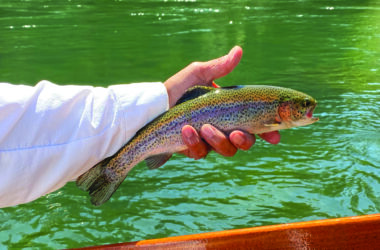The recent heavy rain that swept across the state brought moderate flooding to many coastal rivers and streams. But nowhere in Oregon was the flooding critical.
It was a good flushing, and as the waters began to recede, anglers were delighted to find the first push of winter steelhead had arrived.
Unlike in some seasons, where the run builds from north to south, I have reports of “fair to good” early season steelheading from the Necanicum on the far north coast; the Necanicum historically has one of the earliest hatchery-produced steelhead runs on the coast.
All the way down the coast to the Chetco River, which is not far from the California border, it isn’t a particularly out-of-the-ordinary occurrence, but my contacts there tell me the fishing has been consistent and like what you might find in mid-January.
Winter steelhead have arrived to rivers and streams of the Oregon coast. Successful anglers will do their homework before hitting the river. Find the level on your favorite steelhead river at this link: waterdata.usgs.gov/or/nwis/current/?type=flow.
Locally, a handful of steelhead were caught in the Whittaker to Wildcat section of the Siuslaw River just before Christmas. A bit to the north on the Alsea River, steelhead are “lightly disturbed” throughout the entire length of the river and, like the Siuslaw, a few fish were also caught there. To the south, the main Umpqua River has fired up, too. The largest river on the coast, it is one of only a couple of others whose drainage gathers from crest of the Cascade Mountains and continues all the way to the Pacific Ocean.
In an El Niño year, the atmospheric condition adds to the difficulty of predicting the weather. But it appears that more wet weather is in our future, most of that looks to be “moderate.” The precipitation should help sustain river levels that at press time were about perfect. The unstable weather will surely bring fluctuations in river levels, possibly pushing them out of shape for a couple of days. So you will want to save the NOAA river level forecast page to your “favorites” on your portable cell device. And refer to it before committing to a day of steelhead fishing anywhere in the state.
On the Siuslaw, ideal conditions occur at 8 feet at the Mapleton gage station near and falling. On the Alsea below Mill Creek, the best fishing is at 7 feet and falling. Up river from Mill Creek in the bank fishing section, the ideal level is 8 feet and falling. The Alsea River gage station is located near Tidewater. The Umpqua is a much larger river than either of the other two rivers I’ve highlighted here. It has two major tributaries: the North and South Forks to become the Main Umpqua River. All the steelhead in the drainage that naturally spam or are planted through some program of the ODFW. Pass through the main river that serves as a “steelhead highway.” In general, the North Fork steelhead are predominantly wild spawning and nearly all the hatchery steelhead released in the system are planted in the South Fork. Although no steelhead are plants in the main river, it always has the highest concentration of fish through most of the season.
It is also where I spend most of my time winter steelheading. In about the 20 miles of the main Umpqua River upriver from Elkton, Ore. In this section bank fishing is accessible from Yellow Creek, upriver for a dozen miles. Downriver from Yellow Creek you will need a boat. For power boats, the main Umpqua fishes best when the river gage near Elkton is 9 feet and falling. Drift boat fishing can be exceptional at a gage level of 4.5 feet and falling. The winter steelhead season looks hopeful and it’s just the beginning.
Email: [email protected]








